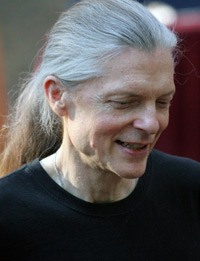Erowid Character Vaults
Alex Grey
Extended Biography
v1.1 - Nov 10, 2009
Citation: Hanna J. "Erowid Character Vaults: Alex Grey Extended Biography". Erowid.org. Nov 10, 2009.

Photo by Jon Hanna |
Starting in the second half of the 1970s, Alex worked at a medical school morgue, sometimes incorporating the morgue's corpses into his performance art. At a party in 1975, he took LSD for the first time and met the artist Allyson Rymland, whom he later married. During his acid trip, Alex had a numinous vision of a tunnel changing from black to grey to white. He interpreted this vision as a resolution to the dualistic polarities that he had been struggling with in his art, and it inspired him to change his last name to "Grey," which represented a middle path between extremes. (By shifting his family name, Velzy, to the middle-name slot, his initials also reflected this path, becoming the abbreviation for "average".) On LSD together in 1976, Alex and Allyson simultaneously shared a psychedelic vision of an infinite omni-directional love energy that comprised the foundational scaffolding of the universe. Experiencing themselves as part of this "oneness of God" caused the illusionary veil of the material world to drop away, inspiring them both to focus on the theme of transcendental spirituality in their art. (Alex depicted their shared vision in his 1981 painting Universal Mind Lattice, while Allyson depicted it in her 1988 painting Jewel Net of Indra.) In 1979, Alex began working on the twenty-one life-sized paintings that make up his Sacred Mirrors series. These images, which took ten years to complete, showcase his "X-ray" style of painting, exposing the material, mental, and spiritual realms common to all of humanity. Alex's more recent paintings depict transpersonal/cosmic beings composed from flaming grid-works of eyes.
For a decade, Alex taught artistic anatomy and figure sculpture at New York University. He continues to occasionally teach art courses through The Open Center, the Naropa Institute, the California Institute of Integral Studies, and the Omega Institute. Alex has spoken worldwide at conferences and gatherings about the positive effect that the judicious use of psychedelics has had on his life and art. His paintings have been appropriated for use on rave flyers and blotter art, published in numerous magazines, used as book covers, featured on album covers by the Beastie Boys, David Byrne, Michael Hedges, Nirvana, The String Cheese Incident, and Tool, and exhibited worldwide in galleries, museums, and at festivals. A mid-career retrospective of Alex's works was exhibited in 1999 at San Diego's Museum of Contemporary Art. Around that time, Alex and Allyson began working to create the Foundation for the Chapel of Sacred Mirrors, Ltd., a non-profit organization dedicated to the idea that art can assist in the positive transformation of individuals and societies.
On September 22, 2004, the Foundation opened the Chapel of Sacred Mirrors (CoSM) as a sanctuary for contemplation in New York City. Numerous paintings by the Greys--including Alex's Sacred Mirrors--were on display at CoSM, and the associated MicroCoSM Gallery held 6-7 exhibits yearly, featuring sacred art from other contemporary artists. By sponsoring regular events and discussion forums, CoSM acted as an East Coast hub for visionary art and culture. At the end of 2008, the CoSM Gallery in New York City closed, as the Foundation purchased land in upstate New York on which to build a larger, permanent facility.
Through his web sites, Alex sells his original art, limited edition prints, books, posters, DVDs, CDs, calendars, clothing, jewelry, a deck of Sacred Mirrors Cards, die-cast metal frames, notecards, stickers, and the Mindfold--a light-tight blindfold with earplugs that he designed to assist inner journeying.

